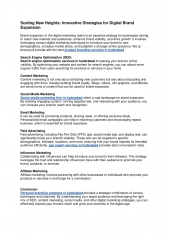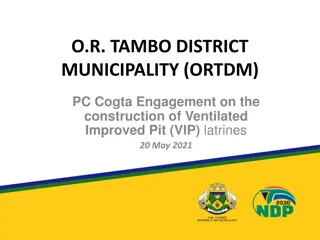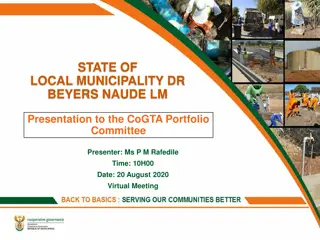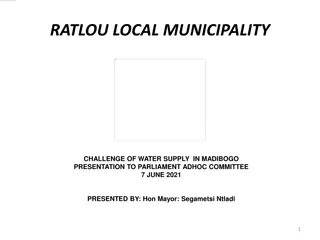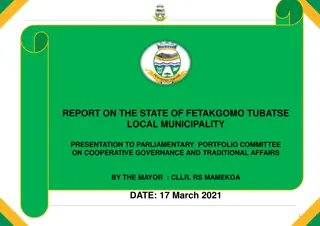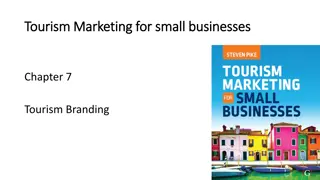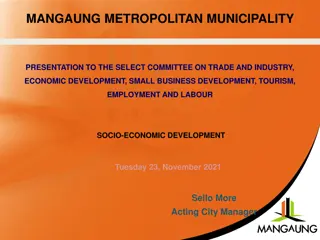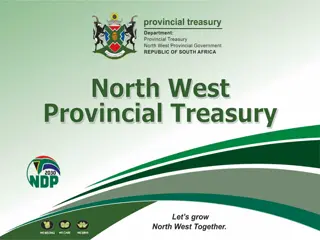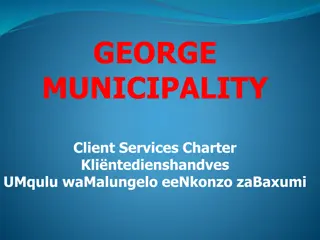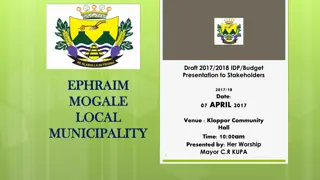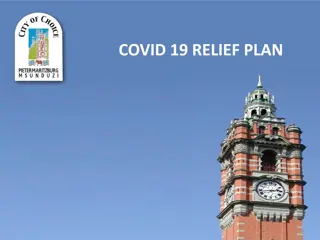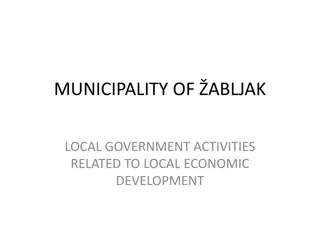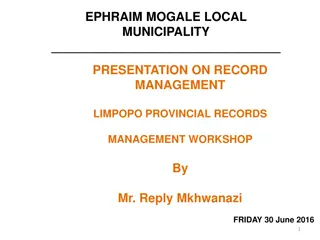Municipality Branding Guidelines for Effective Corporate Identity Management
Municipality Branding Guidelines aim to ensure consistent and effective visual representation of the municipality by providing clear directives on logo usage, color schemes, font types, and design elements. These guidelines help maintain corporate identity continuity across all applications, promoting recognition and professionalism. The Marketing & Communication Unit/Office plays a crucial role as the custodian of the corporate image, responsible for maintaining a corporate identity manual and facilitating graphic design processes for new applications.
- Branding Guidelines
- Municipal Branding
- Corporate Identity Management
- Visual Representation
- Marketing Communication
Download Presentation

Please find below an Image/Link to download the presentation.
The content on the website is provided AS IS for your information and personal use only. It may not be sold, licensed, or shared on other websites without obtaining consent from the author. Download presentation by click this link. If you encounter any issues during the download, it is possible that the publisher has removed the file from their server.
E N D
Presentation Transcript
Municipality Branding Guidelines
The ideal municipality Providing democratic and responsible government for local communities. Being responsive to the needs of the local community. Promoting social and economic development. Ensuring sustainable service delivery to communities. Facilitating a culture of public service and accountability among its staff. Encouraging the involvement of communities and community organisations in the matters of Local Government. Assigning clear responsibilities for the management and coordination of these administrative units and mechanisms. Promoting a safe and healthy environment. *SALGA Handbook for Municipal Councilors, 2011 2
Brand Guidelines will assist Municipal employees, suppliers and partners to use the graphic elements of the corporate brand consistently in all applications including business cards, signs, brochures, web pages, promotional items or any other use. Direction needs to be provided to all officials of the municipality regarding the basic requirements of branding guidelines within the municipality and standards set for municipal branding.
DEFINITIONS Branding Branding is the visual representation of the municipality or product, encompassing the municipality s name, logo and visual appeal. The components usually consist of a logo one or two main colours and two or three additional colours; one or two different fonts; and some graphic design rules and elements.
PURPOSE To provide guidelines for the management of the Municipality s corporate identity and branding; To maintain continuity and consistency in all applications, of the corporate identity and branding guidelines.
BRANDING POLICY GUIDELINES The custodian of the corporate image is the Marketing & Communication Unit/Office of the Municipality. The Unit/Office must maintain a corporate identity manual, with examples of all approved applications, which must be available in a hard copy format from the Marketing & Communication Unit/Office or on the intranet and on the external website The Marketing & Communication Unit/Office must facilitate the graphic design process of any new applications needed.
BRANDING GUIDELINES LIST LANGUAGE POLICY STATIONERY FORMS FOR EXTERNAL AND INTERNAL USE PUBLICATIONS BRANDING MATERIAL ADVERTISING MATERIAL ELECTRONIC COMMUNICATION
PROMOTIONAL MATERIAL AND CORPORATE GIFTS NOTICEBOARDS AND NOTICES INTERNAL AND EXTERNAL SIGNAGE INTERIORS OF AND ENTRANCES TO MUNICIPAL BUILDINGS AND FACILITIES UNIFORMS AND CORPORATE CLOTHING IN GENERAL
MUNICIPAL VEHICLES BREACH OF POLICY GUIDELINES SUPPORTING POLICIES AND GUIDELINES POLICY REVIEW CO-BRANDING
Image Image is the impression clients or consumers have of the municipality s total personality (real and imaginary qualities and shortcomings). Corporate identity Corporate identity is the visual means by which the municipality is recognised. It is also a means of conveying the ways, in which it carries out, and values inherent in, its activities.
The journey to defining the SALGA Brand The SALGA primary logo was designed with the intent of significantly improving the sense of inter-connectedness: with each other, with our members, with other spheres of government, with international think tanks, the private sector and other successful local government associations. Most importantly, it creates a greater sense of affinity with the people and communities we serve. The primary logo is uniquely distinctive, while still remaining practical and simple in it s design, it will be identified as the mark of a quality brand.
[BRAND POSITIONING] THE VOICE OF LOCAL GOVERNMENT ENABLING THE ENABLER Barron Brand-On-A-Page [RATIONAL BENEFIT] [EMOTIONAL BENEFIT] [THE AUDIENCE INSIGHT] IMPROVEMENT A BETTER QUALITY OF LIFE RESPONSIVE, INNOVATIVE LOCAL GOVERNMENT ENABLING A BETTER QUALITY OF LIFE [BRAND BELIEFS] [BRAND TONE] [BRAND BEHAVIOUR] WHERE THERE IS A WILL, THERE IS A WAY. EMBRACING POSITIVE CHANGE. AGILE IMPROVING CONSTRUCTING CREATING SOLUTIONS ACTION- ORIENTATED CONSULTATIVE INFORMED MANDATED CREDIBLE ACCOUNTABLE [BRAND PURPOSE] A CATALYST FOR POSITIVE CHANGE [REASON TO BELIEVE] WE LISTEN, WE UNITE AND WE INFLUENCE WE REPRESENT, ADVOCATE, SUPPORT, ADVISE. 13
Brand identity Brand identity indicates how the municipality wants its inhabitants to perceive its brand. Brand equity Brand equity is the value of the positive sentiment that a brand has created amongst the municipal inhabitants.
Brand management Brand management is the process of maintaining, improving and upholding a brand so that the name is associated with positive results. Besides corporate identity, brand management involves a number of important aspects such as customer relations and satisfaction, business processes, staff motivation and internal communication. Brand management is built on a marketing foundation, but focuses directly on the brand and how that brand can remain favourable to customers
CO-BRANDING Generally the Municipality logo may be used together with the logos of other stakeholders. The role of the Municipality should, however, be defined. Phrases such as the following may be used to illustrate the municipality s relation to the event or programme. o Proudly sponsored by Municipality o Proudly supported by Municipality o Co-organised by the Municipality.
Level 1-branding partners If the Munacipality is the main sponsor there are two options. In each case the Municipality logo should always take a position of priority. It should always be on the left-hand side or above the party seeking endorsement. The level 1-branding partner logo should be no more than 3/4 of the Municipality logo.
Level 2-branding partners Co-branding transversal programmes. The Municipality logo should be no less than 3/4 of the level 2-branding partner logo. Level 3-branding partners If the branding partner is the lead sponsor, the Municipality logo should be equal to or no less than 3/4 of the party seeking endorsement.
Special projects When co-branding a special project such as 10 years of Freedom, the following rules apply: the Municipality logo must always be above or on the left-hand side of the special project logo. In this manner the Municipality logo will be read first. The Municipality logo and the special projects logo should be same size.
Multiple partners When the Municipality is the main sponsor, the Municipality logo should always be above the co- sponsor logos. The co-sponsor logos should be no more than 1/2 of the Municipality logo. When the Municipality is one of the co-sponsors, the Municipality logo should always be on the left- hand side of the other co-sponsor logos.













